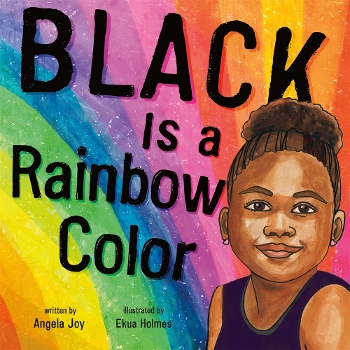Caldecott Honoree and Coretta Scott King Book Award winner Ekua Holmes wows readers with her meticulous illustrations in Black Is a Rainbow Color, written by Angela Joy.
 Caldecott Honoree and Coretta Scott King Book Award winner Ekua Holmes wows readers with her meticulous illustrations in Black Is a Rainbow Color, written by Angela Joy. The story starts with a young African American girl coloring a rainbow and notes that her color, black, is not in the rainbow.
Caldecott Honoree and Coretta Scott King Book Award winner Ekua Holmes wows readers with her meticulous illustrations in Black Is a Rainbow Color, written by Angela Joy. The story starts with a young African American girl coloring a rainbow and notes that her color, black, is not in the rainbow.
From the start, I noticed thick, black, dominant lines that stood out amid radiant colors. The girl's crayons spread across two pages, as she draws with a black crayon on a large white sheet of paper. My first thought was: although black is not in the rainbow, black is certainly present on the page, and the black outlines are definitely making the colors pop.
Holmes's thoughtful mixed-media details, such as her use of civil rights movement-related newspaper clippings, help set her work apart. As a previous Caldecott committee member, I'm familiar with the process of examining illustrations down to the smallest detail. And in my work evaluating children's literature, I've come across books that include random newspaper clippings that are not related to the story. Yes, the information in newspaper clippings can make a huge difference. It appears Ekua Holmes selected specific newspaper articles relevant to the civil rights movement to include in the sidewalk of the marching protesters. She artfully describes the history of protesting in this particular double-page spread.
Other media, including a road map that flows across the spread on Thurgood Marshall, is striking to the eye. I can imagine a child exploring this page by following the lines with their finger, which may ignite questions about all the places Thurgood Marshall traveled. Thin, squiggly, complementary-colored lines on the map imply Thurgood's movement around the United States of America. Holmes added diagonal train tracks, as well as images of trains moving about on the page. The curved and diagonal lines are not overly done; it's just right.
Now, Caldecott committee members are not supposed to compare, but I'm going to briefly do so. When I think of Ekua Holmes, I associate silhouettes with her work. For example, The Stuff of Stars and Out of Wonder both feature silhouettes on the cover. Instead, here we have a beautiful brown-skinned girl with arched eyebrows; pretty eyes; a ponytail; pink, heart-shaped earrings (similar to what my mother used to put in my ears); and a million-dollar smile. She is picture-ready. So, instead of Holmes's signature silhouettes, we see a more humanized character. I applaud Holmes for stepping outside of her norm.
The most powerful spread features women leaders of the civil rights movement, pictured in a church structure's stained-glass windows. For many African Americans, the Black church serves as a foundation. Growing up in the African Methodist Episcopal Church, and now as a member and a mother, I've seen first-hand how Black women and mothers are the backbones of their families and the church. When our Black children go out into the world, we pray. When our Black boys go out into the world, we pray even harder. When we're happy, we pray. When the world is in disarray, we pray. When blessings overflow, we say hallelujah. We give praise through the good, bad, and the ugly. From slavery till now, it's faith that helps us persevere through trials and tribulations.
It's also worth nothing that the civil rights movement originated in the Black church and served as a footing for activists. Holmes's illustrations of Mamie Till-Mobley, Ella Baker, Marian Wright Edelman, and Fannie Lou Hamer are mighty, with Holmes capturing such emotion in each stained-glass portrait. It's such a profound nod to and recognition of the women who played a pivotal role in the civil rights movement.
Sepia-toned hues ignite passionate feelings of warmth and richness in this celebration of Black culture. Holmes's illustrations announce the beauty of what it means to be Black. She extends the text solely through art. She gives clues within the art on various spreads about who the author is referencing in this poetically penned picture book.
[Read the Horn Book Magazine review of Black Is a Rainbow Color here}
At fifteen months, my baby girl saw this book, picked it up, and rubbed her tiny hands across the girl's face on the cover; I could not have been happier. Black Is a Rainbow Color is Caldecott baby-approved. (Kidding!)
There's more to say about this book. However, I'll leave the rest for the committee!

ALREADY A SUBSCRIBER? LOG IN
We are currently offering this content for free. Sign up now to activate your personal profile, where you can save articles for future viewing.








Add Comment :-
Comment Policy:
Comment should not be empty !!!
Julie Danielson
Erica's daughter = future Caldecott committee member!Posted : Oct 04, 2020 04:52
Allison Khoury
What an excellent review of this inspiring and beautiful book. Ekua Holmes continues to share the diversity of her artistic gifts, lucky for all of us and our children. And your daughter's response - made my heart swell with gratitude - priceless.
Posted : Sep 28, 2020 05:19